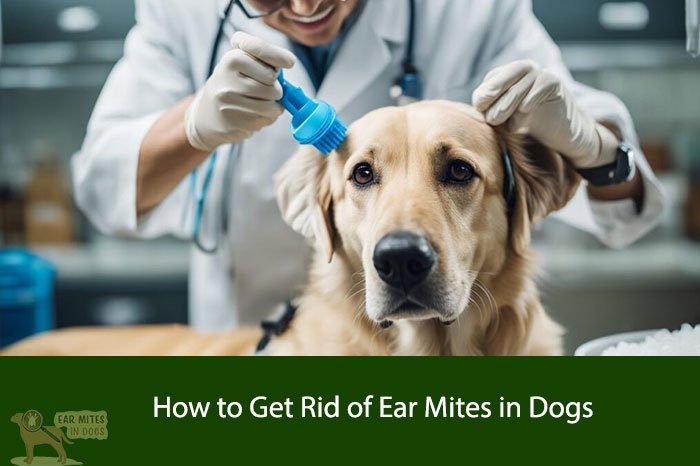Ear mites are a common problem for dogs, especially those who spend a lot of time outdoors or live in multi-dog households. These tiny parasites can cause discomfort and irritation for your furry friend, and if left untreated, can lead to more serious health issues. Fortunately, there are several effective ways to get rid of ear mites in dogs.
The first step in treating ear mites is to identify the problem. Symptoms of ear mites include shaking of the head, scratching at the ears, and a dark, waxy discharge from the ear canal. If you suspect that your dog has ear mites, it’s important to take them to the veterinarian for a proper diagnosis. Once the problem has been identified, you can begin treatment.
There are several treatment options for ear mites in dogs, including topical medications, oral medications, and home remedies. Your veterinarian can recommend the best course of treatment for your dog based on their individual needs and health history. With proper treatment, you can help your furry friend get rid of ear mites and prevent them from returning in the future.
Understanding Ear Mites in Dogs

Ear mites are tiny parasites that can cause discomfort and irritation to dogs. They are commonly found in the ear canal and feed on the skin debris and wax inside the ear. Ear mites are highly contagious and can easily spread from one dog to another through close contact. In this section, we will discuss how to identify ear mites, the symptoms of infestation, and the lifecycle of ear mites.
Identifying Ear Mites
Ear mites are tiny, white, and oval-shaped parasites that can be seen with the naked eye. They are about the size of a pinhead and can move quickly inside the ear canal. Ear mites are more commonly found in puppies and dogs that spend a lot of time outdoors or in close contact with other dogs. If you suspect that your dog has ear mites, it is important to take them to the vet for a proper diagnosis.
Symptoms of Infestation
The symptoms of ear mite infestation can vary from dog to dog. Some dogs may not show any symptoms at all, while others may show signs of discomfort and irritation. Some common symptoms of ear mite infestation include:
- Scratching or rubbing of the ears
- Head shaking or tilting
- Redness and inflammation of the ear canal
- Dark, waxy discharge from the ear
- Foul odor coming from the ear
If you notice any of these symptoms in your dog, it is important to take them to the vet for a proper diagnosis and treatment.
Lifecycle of Ear Mites
Ear mites have a relatively short lifecycle of about three weeks. The female ear mite lays her eggs inside the ear canal, which hatch into larvae in about four days. The larvae then feed on the skin debris and wax inside the ear canal and develop into nymphs in about a week. The nymphs then mature into adult ear mites in about two weeks and start the cycle again by laying their eggs inside the ear canal.
In conclusion, ear mites are a common problem in dogs that can cause discomfort and irritation. It is important to take your dog to the vet if you suspect that they have ear mites. By understanding the symptoms of infestation and the lifecycle of ear mites, you can help prevent and treat this common problem in dogs.
Preventative Measures

When it comes to ear mites in dogs, prevention is always better than cure. Here are some preventative measures you can take to keep your dog’s ears healthy and free of mites.
Routine Ear Cleaning
Regular ear cleaning is crucial to prevent ear mites. You should clean your dog’s ears at least once a week, or more often if your dog is prone to ear infections. Use a gentle, vet-approved ear cleaner and cotton balls or pads to clean the outer ear. Be sure not to insert anything into the ear canal, as this can damage the ear and cause infection.
Environmental Control
Ear mites are highly contagious, so it’s important to keep your dog away from other dogs with ear mites. If your dog does come into contact with an infected dog, be sure to clean their bedding, toys, and any other items they may have shared to prevent the spread of mites. Regularly vacuuming and dusting your home can also help prevent ear mites, as they can live in carpets and upholstery.
Regular Vet Check-Ups
Regular vet check-ups are crucial to catching ear mites early. Your vet can examine your dog’s ears and detect any signs of mites or infections. They can also recommend preventative measures and prescribe medication if necessary. Be sure to schedule regular check-ups for your dog to keep their ears healthy and free of mites.
By following these preventative measures, you can help keep your dog’s ears healthy and free of ear mites. Remember to always consult with your vet if you suspect your dog has ear mites or any other ear-related issues.
Home Remedies

Natural Oils
One of the most effective home remedies for treating ear mites in dogs is the use of natural oils. These oils can help soothe the irritation caused by the mites and also help to suffocate them. Some of the oils that can be used include:
- Olive oil
- Coconut oil
- Almond oil
- Mineral oil
To use these oils, warm them up slightly and then use a dropper to apply a few drops into your dog’s ear canal. Massage the base of the ear gently to help the oil penetrate deeper. Repeat this process every day for a week or until the mites are gone.
Homemade Solutions
Another effective home remedy for ear mites in dogs is using homemade solutions. These solutions can help to kill the mites and also soothe the irritation. Here are a few homemade solutions that you can try:
- Apple cider vinegar solution: Mix equal parts of apple cider vinegar and water and use a dropper to apply a few drops into your dog’s ear canal. Massage the base of the ear gently and then wipe away any excess solution.
- Hydrogen peroxide solution: Mix equal parts of hydrogen peroxide and water and use a dropper to apply a few drops into your dog’s ear canal. Massage the base of the ear gently and then wipe away any excess solution.
- Saltwater solution: Mix 1 teaspoon of salt in 1 cup of warm water and use a dropper to apply a few drops into your dog’s ear canal. Massage the base of the ear gently and then wipe away any excess solution.
It is important to note that while these home remedies can be effective, they should not be used as a substitute for veterinary care. If your dog’s ear mite infestation is severe or does not improve after using these remedies, it is important to seek veterinary care.
Medicinal Treatments

Topical Medications
Topical medications are applied directly onto the ear canal of the dog, and they are effective in killing ear mites. Some of the commonly used topical medications include Acarexx, Tresaderm, and Otomite Plus. These medications contain active ingredients such as pyrethrins, which kill the mites on contact. It is important to follow the instructions provided by the manufacturer and to apply the medication as directed.
Oral Medications
Oral medications are another way to treat ear mites in dogs. These medications are usually prescribed by a veterinarian and are effective in killing the mites. Some of the commonly used oral medications include ivermectin and milbemycin. These medications are usually given once a month and can also help prevent other parasites such as heartworms.
Prescription Ear Drops
Prescription ear drops are another option for treating ear mites in dogs. These drops are usually prescribed by a veterinarian and contain medication that is applied directly into the ear canal. Some of the commonly used prescription ear drops include Tresaderm and Mometamax. These drops are effective in killing the mites and reducing inflammation in the ear.
It is important to consult with a veterinarian before using any medication to treat ear mites in dogs. They can help determine the best treatment option based on the dog’s individual needs and medical history.
Cleaning Infected Ears

When it comes to cleaning your dog’s ears, it is important to be gentle and use safe techniques to avoid further irritation. Here are some tips on how to safely clean your dog’s ears:
Safe Cleaning Techniques
To begin, gather the necessary supplies: cotton balls or gauze, a gentle ear cleaning solution, and treats for your dog. It’s important to use a cleaning solution specifically designed for dogs, as human ear cleaners can be too harsh and cause irritation.
Next, gently lift your dog’s ear flap and apply a small amount of the cleaning solution to the ear canal. Massage the base of the ear to distribute the solution, then use a cotton ball or gauze to gently wipe away any debris or excess solution.
It’s important to never use cotton swabs or insert anything into your dog’s ear canal, as this can cause injury or further irritation.
Avoiding Further Irritation
After cleaning your dog’s ears, it’s important to avoid further irritation. Keep your dog’s ears dry and avoid exposing them to water or moisture. If your dog has long ears, consider using a headband or tying their hair back to keep their ears out of their food and water bowls.
If your dog is prone to ear infections or has chronic ear issues, it’s important to consult with your veterinarian for further guidance and treatment options.
By following these safe cleaning techniques and avoiding further irritation, you can help keep your dog’s ears healthy and free of ear mites.
Monitoring and Follow-Up Care
After treating your dog for ear mites, it is important to monitor their progress and provide follow-up care to ensure that the mites are completely eliminated. Here are a few things to keep in mind during the monitoring and follow-up care process.
Observing Improvement
After treating your dog for ear mites, it is important to observe their behavior and look for signs of improvement. Some of the signs that your dog’s ear mites are improving include a decrease in scratching and head shaking, a reduction in redness and inflammation in the ear, and a decrease in the amount of earwax produced.
If you notice any of these signs, it is a good indication that the treatment is working and that your dog’s ear mites are being eliminated. However, if you do not see any improvement after a few days, you may need to revisit your treatment plan or consult with your veterinarian.
Preventing Recurrence
To prevent a recurrence of ear mites in your dog, it is important to take steps to keep their ears clean and healthy. This includes regularly cleaning your dog’s ears with a gentle, veterinarian-approved ear cleaner, and ensuring that their ears are kept dry and free from moisture.
You should also take steps to prevent your dog from coming into contact with other animals that may have ear mites, and make sure that their bedding and living areas are kept clean and free from mites.
By following these steps, you can help to prevent a recurrence of ear mites in your dog and ensure that their ears remain healthy and free from infection.
Frequently Asked Questions

What is the most effective way to treat ear mites in dogs?
The most effective way to treat ear mites in dogs is by using prescription medication from a veterinarian. These medications are specifically designed to kill ear mites and prevent further infestations. Some common medications include selamectin, ivermectin, and milbemycin oxime. It is important to follow your veterinarian’s instructions closely when administering these medications.
Can home remedies effectively eliminate ear mites in dogs, and what are they?
While some home remedies may provide temporary relief, they are not typically effective in eliminating ear mites in dogs. Some common home remedies include cleaning the ears with vinegar or hydrogen peroxide, applying mineral oil or olive oil to the ears, and using herbal remedies. However, these remedies may not kill all of the mites and can sometimes worsen the condition.
What are the signs and symptoms that indicate a dog may have ear mites?
The signs and symptoms of ear mites in dogs include excessive scratching or rubbing of the ears, head shaking, redness and inflammation of the ears, a dark discharge from the ears, and a foul odor. If you notice any of these symptoms, it is important to take your dog to the veterinarian for diagnosis and treatment.
How can you distinguish between an ear mite infestation and an ear infection in dogs?
An ear mite infestation and an ear infection in dogs can have similar symptoms, but there are some key differences. Ear mites typically cause intense itching and scratching of the ears, while ear infections may cause pain and sensitivity. Additionally, ear mites often produce a dark, waxy discharge from the ears, while ear infections may produce a yellow or green discharge.
What is the typical duration for treating and clearing ear mites in canines?
The duration for treating and clearing ear mites in canines can vary depending on the severity of the infestation and the effectiveness of the treatment. Typically, a course of medication will last for several weeks, and it is important to follow up with the veterinarian to ensure the mites have been eliminated.
Is it possible to prevent ear mites in dogs, and what steps should be taken?
It is possible to prevent ear mites in dogs by practicing good hygiene and keeping your dog’s ears clean and dry. Regularly inspect your dog’s ears for signs of infestation, and take them to the veterinarian for regular checkups. Additionally, avoid contact with other animals that may have ear mites, and keep your dog’s environment clean and free of pests.





